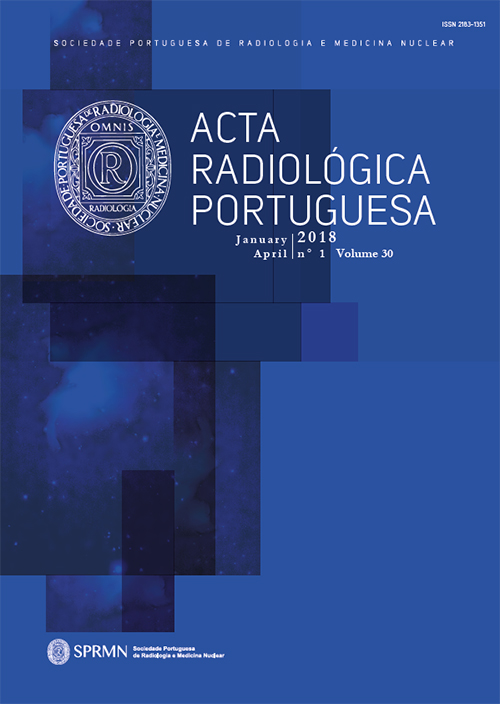The Role of Radiology in Detecting Prosthetic Breast Implant-Related Complications
DOI:
https://doi.org/10.25748/arp.13574Resumen
Given the growing number of breast implants, both for aesthetic and reconstructive purposes, it is imperative for the Radiologist, to know the different types of surgical procedures involved, as well as the various types of implants available. Several types of early or late complications can result from this. The prosthesis rupture represents one of the most frequent kinds of late complication and constitutes the foremost cause of its removal. Since its clinical manifestation may be absent in up to 50% of cases, Radiology plays a central role in its monitoring. In Portugal, MR surveillance is not recommended by the national health program. Ultrasound examination along with screening mammography is the usual preferred method.
Thus, although breast implants imaging constitutes a low percentage of the day-to-day care activity of a Radiologist, the knowledge of the different imaging findings in the multimodality imaging used is crucial for early diagnosis of these complications and to provide the best patient care possible.
Citas
Czerny V. Plastic replacement of the breast with a lipoma. Chir Kong Verhandl. 1895; 2:216.
Cronin TD, Brauer RO. Augmentation mammaplasty. Surg Clin North Am. 1971; 51:441–52.
International Society of Plastic Aesthetic Surgery. (2017) International Study On Aesthetic/Cosmetic Surgery Procedures Performed In 2016. Available at: http://www.isaps.org/Media/Default/Current%20News/GlobalStatistics2016.pdf. Accessed November 04, 2017.
Albornoz CR, Bach PB, Mehrara BJ, Disa JJ, Pusic AL, McCarthy CM, et al. A paradigm shift in U.S. breast reconstruction: increasing implant rates. Plast Reconstr Surg. 2013; 131:15–23.
Pelosi, Marco A. III, Pelosi, Marco A. II. Breast Augmentation. Obstet Gynecol Clin North Am. 2010; 37:533-46.
Green L.A, Karow JA, Toman JE, Lostumbo A, Xie K. Review of breast augmentation and reconstruction for the radiologist with emphasis on MRI. Clinical Imaging. 2018; 47:101-17.
Maxwell GP, Gabriel A. Breast implant design. Gland Surg. 2017; 6:148-53.
Yang N, Muradali D. The augmented breast: a pictorial review of the abnormal and unusual. AJR Am J Roentgenol. 2011; 196:451–60
Pittet B, Montandon D, Pittet D. Infection in breast implants. Lancet Infect Dis. 2005; 5:94-106.
Namnoum J, Largent J, Kaplan H, et al. Primary breast augmentation clinical trial outcomes stratified by surgical incision, anatomical placement and implant device type. J Plast Reconstr Aesthet Surg. 2013; 66:1165-72.
Siggelkow W, Faridi A, Spiritus K, Klinge U, Rath W, Klosterhalfen B. Histological analysis of silicone breast implant capsules and correlation with capsular contracture. Biomaterials. 2003; 24:1101–09.
JF Wiedenhoefer, H Shahid, C Dornbluth, P Otto, K Kist. MR imaging of breast implants: Useful information for the interpreting radiologist. Appl Radiol. 2015; 44:18-24.
Chung KC, Malay S, Shauver MJ, Kim HM. Economic analysis of screening strategies for rupture of silicone gel breast implants. Plast Reconstr Surg. 2012; 130:225-37.
Di Benedetto G, Cecchini S, Grassetti L, Baldassarre S, Valeri G, Leva L, et al. Comparative study of breast implant rupture using mammography, sonography, and magnetic resonance imaging: correlation with surgical findings. Breast J. 2008; 14:532-7
Norma da DGS nº 051/2011, “Abordagem Imagiológica da Mama Feminina”.
Brown SL, Middleton MS, Berg WA, Soo MS, Pennello G. Prevalence of rupture of silicone gel breast implants revealed on MR imaging in a population of women in Birmingham, Alabama. AJR Am J Roentgenol 2000; 175:1057-64.
Juanpere S, Perez E, Huc O, Motos N, Pont J, Pedraza S. Imaging of breast implants—a pictorial review. Insights into Imaging. 2011; 2:653-70.
Gorczyca David P, Gorczyca Stephanie M, Gorczyca Kathryn. The diagnosis of silicone breast implant rupture. Plast Reconstr Surg. 2007; 120:49-61.
Seiler SJ, Sharma PB, Hayes JC, Ganti R, Mootz AR, Eads ED, Teotia SS, Evans WP. Multimodality Imaging-based Evaluation of Single-Lumen Silicone Breast Implants for Rupture. Radiographics. 2017; 37:366-82.
Brenner RJ. Evaluation of breast silicone implants. Magn Reson Imaging Clin N Am. 2013; 21:547–60.
Everson LI, Parantainen H, Detlie T, Stillman AE, Olson PN, Landis G, et al. Diagnosis of breast implant rupture: imaging findings and relative efficacies of imaging techniques. AJR Am J Roentgenol. 1994; 163:57-60.
Berg WA, Caskey CI, Hamper UM, Anderson ND,Chang BW, Sheth S, et al. Diagnosing breast implant rupture with MR imaging, US, and mammography. RadioGraphics 1993; 13:1323–36
Gorczyca DP, Sinha S, Ahn CY, et al. Silicone breast implants in vivo: MR imaging. Radiology. 1992; 185:407-410.
Sutton EJ, Watson EJ, Gibbons G, Goldman DA, Moskowitz CS, Jochelson MS, et al. Incidence of internal mammary lymph nodes with silicone breast implants at MR imaging after oncoplastic surgery. Radiology.2015; 277:381-87.
Ye X, Shokrollahi K, Rozen WM, Conyers R, Wright P, Kenner L, et al. Anaplastic large cell lymphoma (ALCL) and breast implants: breaking down the evidence. Mutat. Res./Rev. Mutat. Res. 2014; 762:123-32.
Ilonzo N, Tsang A, Tsantes S, Estabrook A, Ma AMT. Breast reconstruction after mastectomy: a ten-year analysis of trends and immediate postoperative outcomes. Breast. 2016; 32:7-12.
Descargas
Archivos adicionales
Publicado
Número
Sección
Licencia
CC BY-NC 4.0


